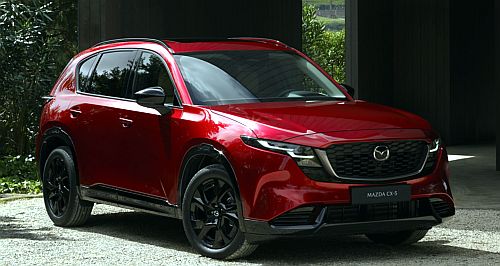Make / Model Search
Future models - Mazda - CX-5Bigger third-gen Mazda CX-5 revealed in fullLonger and roomier CX-5 carries over petrol power, hybrid to follow later10 Jul 2025 By TOM BAKER FAMILIARITY is the order of the day for the third-generation Mazda CX-5 with a carryover engine and evolutionary chassis underpinning an enlarged body and radically modernised interior.
Revealed at least six months in advance of Australian deliveries commencing in 2026, the new CX-5 replaces the eight-year-old ‘KF’ model that has been a consistent darling of Australian SUV buyers even as the Toyota RAV4 dethroned it from the segment’s top result in 2020.
Globally, the CX-5 is Mazda’s best-selling model and a key pillar of the Hiroshima, Japan-based manufacturer. Despite the relative age of the outgoing model, it remained the second-best selling midsize SUV locally across the first half of 2025 (11,991 units delivered).
Typically for Mazda, Australian sales of the CX-5 have punched well above their weight since the model’s birth in 2012, accounting for seven per cent of total global volume. Locally, sales peaked in 2022 at 27,062 in an expanding segment: that year, Toyota moved 34,845 RAV4s.
GoAuto understands that the new CX-5 uses a deep revision of the second-generation version’s Skyactiv C/D platform, which is itself a modernisation of the first-generation ‘KE’ CX-5—with Mazda opting not to utilise architectures deployed for the smaller CX-30, or the larger CX-60/70/80/89 family.
But while the KE-KF transition saw dimensions remain basically the same, the extent of the overhaul for the third-generation CX-5 is much more significant with a notable 110mm stretch to both body and wheelbase unlocking more cabin and boot space and longer, wider-opening rear doors.
Dimensionally, the new CX-5 measures 4690mm in length (+110mm), 1860mm in width (+12mm), and 1695mm in height (+10mm).
Of concern is the delayed status of a promised petrol-electric hybrid system that will finally allow the Mazda CX-5 to square up against the RAV4—but also an emerging wave of hybrid options from other Asian and European marques.
Mazda continues to polish the future hybrid system, which it is developing in-house in concert with a lower-CO2 Skyactiv-Z family of petrol engines. GoAuto understands the hybrid system will be revealed in 2026 with Australian deliveries commencing sometime later.
The hybrid lag stands in sharp contrast to Toyota Motor Company Australia’s decision to shift its RAV4 to all-hybrid for Australia. Hyundai and Kia have broadened their hybrid lines, and while the Volkswagen Tiguan is currently petrol-only, PHEV options are already in production for Europe.
Mazda’s options are limited, with the CX-5 soldiering on with a carryover engine that has been detuned—a move that should reduce its fuel consumption and CO2 emissions. That’s critical, as the outgoing CX-5’s engine is already in breach of NVES CO2 limits, resulting in financial penalties.
Retaining its 2.5-litre displacement, the naturally aspirated Skyactiv-G four-cylinder now produces 132kW/242Nm (down 8kW/10Nm) with AWD made standard from launch. The hard-charging but dirtier 2.5-litre turbocharged petrol option, and cheaper atmospheric 2.0-litre, are discontinued.
Mazda Australia has already flagged to GoAuto that it will need to consider increasing prices to counter the financial impacts of NVES emissions limits which are now in force. The outgoing CX-5 equipped with 2.5-litre and AWD is priced between $45,895-$53,445 plus on-road costs.
However, the decision to reuse the CX-5’s existing powertrain, and elements of its platform, will theoretically have kept development costs lean, and may abate emissions-based price increases—while retaining well-established mechanicals including a multi-link independent rear suspension.
In Europe, the level of detune is even more substantial to pass emissions regulations—so it could have been worse for Mazda Australia. It claims the carryover 2.5-litre “has proven itself as a popular, reliable offering” with the detuned update being “recalibrated…for sharper response”.
Externally, the CX-5 does not mess with success, largely retaining the proportions of its predecessor with relatively minor tinkering to the fascias and surfacing to incorporate the additional length. The European spec revealed today features an extensive black pack.
By far the most substantial alterations to the CX-5 are found inside—not only is the cabin aesthetic considerably more minimal, but Mazda has invested more resources to rejigging the architecture with components like air vents and key buttons and switches relocated to suit the design.
Rotary control of the infotainment system has been deleted in favour of a larger, higher-resolution, and customisable central touchscreen. Measuring 15.6 inches diagonally and manipulated by smartphone-style gestures, it is the largest panel Mazda has used in any car.
Traditionalists will appreciate that a cowl remains over the digital instrument cluster and the selector for the six-speed automatic remains conventional—but in the other direction, climate control is conducted on the large touchscreen and the steering wheel spoke controls appear to be haptic.
Part of the CX-5’s historical success in Australia can be attributed to the car’s close suitability to Australia’s relatively refined tastes in SUVs—and the fact that the midsize crossover segment was a far less competitive environment in 2012.
The third-generation CX-5 will arrive to face a far fierier class of rivals next year, from a similarly deep revision of the Toyota RAV4 to a range of affordably priced yet generously specified Chinese SUVs tempting away some buyers enduring a cost-of-living pinch.
Illustrating how much tougher it is for Mazda to win is the halving of the CX-5’s market share among midsize SUVs—falling from a dominant 20 per cent in 2015 to 10 per cent across the first half of 2025.
Convincing one in ten buyers to choose a CX-5 remains a remarkable coup—but with new and old rivals on the march, and without a critical hybrid at launch, Mazda will be hoping the CX-5’s third act can engage Australian tastes as strongly as the first and second.
 Read moreAll future models Alfa Romeo Alfa Romeo Abarth Abarth Audi Audi Aston Martin Aston Martin BMW BMW Bentley Bentley Chrysler Chrysler Chevrolet Chevrolet Dodge Dodge Citroen Citroen Ferrari Ferrari DS DS Ford Ford Fiat Fiat FPV FPV Foton Foton Haval Haval Great Wall Great Wall Honda Honda Holden Holden Hyundai Hyundai HSV HSV Isuzu Isuzu Infiniti Infiniti Jaguar Jaguar Iveco Iveco Kia Kia Jeep Jeep Land Rover Land Rover Lamborghini Lamborghini Maserati Maserati Lexus Lexus McLaren McLaren Mazda Mazda Mercedes-Benz Mercedes-Benz Mitsubishi Mitsubishi Mini Mini Opel Opel Nissan Nissan Porsche Porsche Peugeot Peugeot Ram Ram Proton Proton Rolls-Royce Rolls-Royce Renault Renault Skoda Skoda Saab Saab SsangYong SsangYong Smart Smart Suzuki Suzuki Subaru Subaru Toyota Toyota Tesla Tesla Volvo VolvoCX-5 pricing
Motor industry news |
Click to shareMazda modelsResearch Mazda All future models Alfa Romeo Alfa Romeo Abarth Abarth Audi Audi Aston Martin Aston Martin BMW BMW Bentley Bentley Chrysler Chrysler Chevrolet Chevrolet Dodge Dodge Citroen Citroen Ferrari Ferrari DS DS Ford Ford Fiat Fiat FPV FPV Foton Foton Haval Haval Great Wall Great Wall Honda Honda Holden Holden Hyundai Hyundai HSV HSV Isuzu Isuzu Infiniti Infiniti Jaguar Jaguar Iveco Iveco Kia Kia Jeep Jeep Land Rover Land Rover Lamborghini Lamborghini Maserati Maserati Lexus Lexus McLaren McLaren Mazda Mazda Mercedes-Benz Mercedes-Benz Mitsubishi Mitsubishi Mini Mini Opel Opel Nissan Nissan Porsche Porsche Peugeot Peugeot Ram Ram Proton Proton Rolls-Royce Rolls-Royce Renault Renault Skoda Skoda Saab Saab SsangYong SsangYong Smart Smart Suzuki Suzuki Subaru Subaru Toyota Toyota Tesla Tesla Volvo VolvoCX-5 pricing
Motor industry news |











Facebook Twitter Instagram